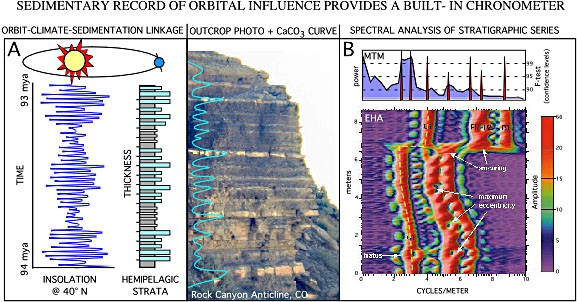As a post doc at Penn State University (1991-92) I participated in the Western Interior Shallow Drilling Project (WISDP), a multi-investigator study organized by Mike Arthur and Walt Dean. As part of this project we drilled the USGS #1 Portland Core in a cement quarry about 30 km west of the Rock Canyon Anticline, CO. One of my subsequent contributions to the project was an investigation of the nature of cyclic deposition in the rhythmically bedded Bridge Creek Limestone Member of the Greenhorn Formation. Collaborators on the two initial papers (Sageman et al., 1997; 1998) resulting from this study included colleagues from Northwestern (J. Rich and E. Birchfield), Penn State (M. Arthur), and the USGS (W. Dean), as well as other members of the WISDP scientific team (C. Savrda and T. Bralower). In this work, Thomson’s (1982) multi-taper method (MTM) was used to test for orbital influence on hemipelagic sedimentation. The result was a novel interpretation of multiple orbital signals recorded within the beds of the Bridge Creek Limestone (Sageman et al., 1997). This work led to speculation that climatic cooling due to carbon burial and CO2 drawdown during OAE II may have resulted in the enhancement of obliquity influence on the higher latitude climate system, and thus caused increased prevalence of obliquity in a precession-
dominated record.
My former graduate student Steve Meyers carried this work forward, developing and applying new spectral methods, and testing the latitudinal hypothesis. Steve and I collaborated with spectral guru Linda Hinnov to develop a moving window version of the MTM, which we termed Evolutive Harmonic Analysis (Meyers et al., 2001). This technique uses perturbations in the preserved orbital signal (due to variations in sedimentation rate) to construct high-resolution orbital time scales. Inversion of the time scale produces a detailed sedimentation rate record (see Fig. 5). With high-resolution sedimentation rates, accumulation rates for a variety of geochemical proxies can then be calculated, leading to significant enhancement in biogeochemical interpretations (Meyers et al., 2001, 2005). NU graduate student, Rob Locklair, is currently pursuing application of these methods in Coniacian-Santonian strata of the Western Interior basin.
A new project with Steve Meyers and Jiri Laurin (see stratigraphic architecture) that grew out of a seminar the three of us taught in Winter 2003 involves the integration of 2-D stratigraphic modeling and advanced spectral techniques to address the relationship between the marginal marine and hemipelagic parts of epeiric sea depositional systems (see Laurin et al., 2005).
